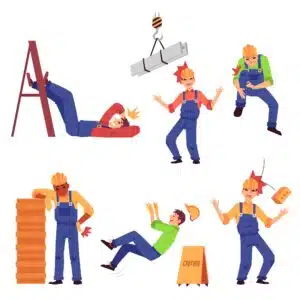Our construction accident compensation case study sets out to explain the accident at work claims process in greater detail. Through our case study, we will examine the employer’s duty of care to their staff, how a breach of this duty could lead to an accident on a construction site and what compensation could be awarded in a successful claim.
You will also see sections on the evidence you could use to prove your employer’s negligence, in addition to how compensation is calculated in personal injury cases, under the two relevant heads of claim.
The final section of the guide examines the type of No Win No Fee contract that solicitors from our panel can provide legal services under and how this benefits potential claimants.
To ask any questions that may have arisen during the reading of this guide or to get a free assessment of your eligibility to start a claim in your specific circumstances, contact an advisor today via our “Contact Us” form.
Browse This Guide
- When Are You Eligible To Make A Construction Injury Claim?
- Construction Accident Compensation Case Study: £500,000 Compensation Payout
- How Much Compensation Could Be Received From Construction Industry Accidents?
- How To Prove Negligence In A Construction Accident Claim
- Claim For A Construction Industry Accident On A No Win No Fee Basis
- Learn More About Making Compensation Claims In The Construction Sector
When Are You Eligible To Make A Construction Injury Claim?
All employers have a duty of care under the Health and Safety At Work etc. Act 1974 to their employees. Per this legislation, an employer must take reasonable steps to keep their labour force safe during their work activities.
That said, employers are not the only party that owes a duty of care on a construction site. Generally, on a construction site, you will have a contractor, subcontractors, site manager, and other companies all working together on the project. Each entity will owe a duty of care for the safety of others. So, if you have been injured while working on a construction site due to poor health and safety practices, it may not be your employer who is liable.
The eligibility criteria for personal injury claims following accidents on construction sites are given here:
- You were owed a duty of care at the time of the accident.
- The party that owed you the duty of care breached it by failing to take reasonable steps to keep you safe during your work activities.
- This breach caused an accident in which you suffered injuries.
For an example of a scenario where a personal injury claim could be made, read our construction accident compensation case study below. You can find out if you are eligible to claim in your particular circumstances by speaking to our advisors using the contact information provided above.
Please note that personal injury claims for accidents at work must generally be started within 3 years of the accident taking place according to the Limitation Act 1980. This means legal proceedings must be initiated within the courts within 3 years. There are exceptions to this, so please contact our advisors for more information.
Construction Accident Compensation Case Study: £500,000 Compensation Payout
In this section, we provide an illustrative construction accident compensation case study to provide a better idea of the compensation you could be awarded for a successful claim.
Case Study
Mr P was working as a power tools operator on a project to expand a leisure centre. He was using an electric drill to bore holes into the brickwork for a large gutter installation. The ladder he had been given to use had a faulty mechanism, but the employer had not replaced the faulty equipment and instructed Mr P to use the ladder anyway.
The ladder gave way while Mr P was operating a power drill. He fell a considerable height and broke multiple bones in his legs, pelvis and shoulder, as well as hitting his head in the fall. After undergoing extensive surgery and physiotherapy, Mr P was able to walk and his mobility improved.
However, Mr P was unable to return to work. Mr P received substantial general damages following his fall at work. He also received substantial special damages for his lost earnings and significant care needs. His total compensation was a sum of £500,000.
How Much Compensation Could Be Received From Construction Industry Accidents?
We touched on the two different heads of claim, general and special damages, in our construction accident compensation case study. This section aims to provide a greater explanation of how compensation in accident at work claims is calculated.
General damages compensate for the physical and psychiatric harm caused by the employer’s breach of their duty of care. Whereas your financial losses that stem from that harm can be reimbursed under special damages.
When instructing a solicitor to represent you as their client, the legal team tasked with calculating a potential value of general damages in your claim can refer to your provided medical evidence and the guideline compensation brackets from the Judicial College. You will be invited to an independent assessment where an expert will provide a report on the injury you have suffered, the prognosis and future medical requirements. Those responsible for valuing general damages will use this report along with compensation guidelines to calculate a figure for this Head of Loss.
Compensation Table
Please take note that the amounts in this table are intended to act as guidance only, as personal injury claims are decided on a case by case basis.
| Type of Injury | Severity | Guideline Compensation Value | Notes |
|---|---|---|---|
| Multiple Serious Injuries with Special Damages Such as Lost Earnings and Medical Expenses. | Very Serious | Up to £1,000,000+ | Cases involving multiple serious injuries in addition to medical expenses, lost earnings, care costs and other special damages. |
| Injuries Resulting From Brain Damage | Very Severe (a) | £282,010 to £403,990 | Factors taken into consideration: life expectancy, the extent of physical limitations, requirement for gastrostomy, sensory impairment, ability to communicate with or without assistive technology. |
| Injuries Resulting From Brain Damage | Moderate (c)(i) | £150,110 to £219,070 | The injured person will have experienced moderate to severe effect on intellect, personality change, effect on their senses and be at significant risk of developing epilepsy. |
| Leg Injuries | Amputation (a)(iii) | £104,830 to £137,470 | An above-knee amputation of a single leg. The level of award will depend on the presence of phantom pain, the success of prosthesis, any side effects such as bakeache and the risk of developing osteoarthritis. |
| Severe (b)(i) | £96,250 to £135,920 | Injuries that are so serious they are treated similarly to an amputation such as fracture that have not united and therefore require extensive bone grafting. | |
| Epilepsy | Established Grand Mal | £102,000 to £150,110 | Compensation for epilepsy can be affected by the following factors: the effectiveness of medication, the impacts on daily life, any behavioural problems and the prognosis of the condition. |
| Bladder | Total Loss of Function (b) | Up to £140,660 | Injuries causing a total loss of bladder control and function. |
| Injuries to the Pelvis and Hips | Severe (a) | £78,400 to £130,930 | Extensive pelvic fractures such as the dislocation of a low back joint and ruptured bladder resulting in a lack of control, sexual dysfunction and hip deformity. |
| Back injuries | Severe (a)(iii) | £38,780 to £69,730 | Cases such as disc fractures or soft tissue injuries resulting in chronic conditions where disabilities such as severe continuing pain and discomfort, impaired agility, personality change and depression remain despite treatment. |
| Other Arm Injuries | Permanent and Substantial Disablement (b) | £39,170 to £59,860 | Serious fractures of the forearms resulting in a significant and permanent residual disability. |
The top entry of this table is not featured in the JCG.
Special Damages In A Construction Accident Claim
As mentioned above, special damages is the second head of claim that compensation can be awarded under. We gave some examples of special damages in our construction accident compensation case study, but have provided further detail here.
Possible examples of special damages include:
- Lost earnings due to time taken off work to recover from your injuries.
- Once you return to work, you may be able to claim compensation for transport costs if you are unable to drive.
- The cost of prescription medication, physiotherapy or other medical costs that need to be paid out of pocket.
- Modifications to your home, including accessibility features like ramps or a walk-in shower, if your injuries have affected your mobility.
- Domestic care and support, such as help with gardening and maintenance, food preparation and cleaning your home if you can no longer carry out these tasks safely by yourself.
These examples have been included to give you an idea of what damages a compensation payout could include. To get a more detailed estimate of the value of your potential claim, talk to an advisor today using the contact information given below.
How To Prove Negligence In A Construction Accident Claim
Proving negligence in a personal injury claim, such as in our construction accident compensation case study, will require the submission of evidence. This evidence will serve three purposes: first of all, that a breach of duty occurred; it will also be used to prove your injuries were the result of a breach in the duty of care, and it can demonstrate the extent of the injuries suffered.
We have provided this list of the possible evidence needed for a personal injury claim:
- Following a workplace accident, it is always recommended that you seek the proper medical treatment. As well as prioritising your health, any X-rays, MRI scans and other tests that were performed can be used in your body of evidence.
- If the construction site was covered by CCTV cameras, you can request a copy of this footage to show how the accident occurred.
- Similarly, anyone who saw the accident occur could provide a witness statement during the claims process, so make sure you have their contact information.
- Employers with 10 or more employees are required, by law, to keep a workplace accident book as a record of workplace incidents. You can get a copy of your incident report to be used as evidence.
- Employer records such as training documents or maintenance logs could be used to show that these tasks were completed improperly or not at all.
You may find it beneficial to work with a solicitor as they can assist with collecting evidence for your claim. Contact our advisory team for a free consultation regarding your eligibility to claim in your particular circumstances. If eligible, a solicitor from our panel of personal injury experts could take on your case and provide support with the collection of evidence.
You can speak to an advisor at any time via the contact information provided below.
Claim For A Construction Industry Accident On A No Win No Fee Basis
You could make a personal injury claim with an experienced work injury solicitor from our panel. Contact our advisors for a free assessment of your eligibility to claim compensation in your particular circumstances. If our team decide you meet the criteria to claim, you could be connected with a No Win No Fee solicitor and offered a Conditional Fee Agreement (CFA).
A CFA is a No Win No Fee contract that provides claimants with some key benefits. When instructing a solicitor under a CFA, you will not incur fees for the solicitor to start work on your claim or during the claims process itself, in most cases. There will similarly be no fee should the claim fail.
In the event of a successful claim, however, you will receive a personal injury compensation award. You and the solicitor will agree to a success fee prior to the start of the claims process. As The Conditional Fee Agreements Order 2013 caps success fee percentages at a maximum of 25%, you, the claimant, will get to keep most of any compensation awarded.
To ask any questions that may have arisen during the reading of this guide or to get a free assessment of your eligibility to start a claim in your specific circumstances, contact an advisor today via our “Contact Us” form.
Learn More About Making Compensation Claims In The Construction Sector
Read some of our other guides on construction injury claims:
- Learn more about finding the best construction accident solicitors for you.
- Read further on construction injury claims here.
- Find out if you could be eligible to sue your employer after a construction site accident, and how a solicitor from our panel could support you.
We have also included some external resources for further information:
- The NHS has provided this overview of falls and their prevention.
- You can read the guidance on planning for construction work from the Health and Safety Executive on their website.
- Read the safety guidance for construction from the Royal Society for the Prevention of Accidents (RoSPA)
We’d like to thank you for taking the time to read our construction accident case study guide. You can ask our advisors for further guidance on any of the topics we have covered. Our dedicated team can also assess your eligibility to begin a personal injury claim at no cost to you. Get in touch today via the contact information provided above.





